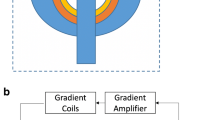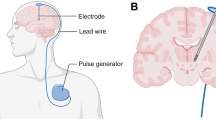Abstract
Purpose
Intra-operative image guidance during deep brain stimulation (DBS) surgery is usually avoided due to cost and overhead of intra-operative MRI and CT acquisitions. Recently, there has been interest in the community towards the usage of non-invasive transcranial ultrasound (TCUS) through the preauricular bone window. In this work, we investigate, for the first time, the feasibility of using 3D-TCUS for imaging of already implanted DBS electrodes. As a first step towards this goal, we report imaging methods and electrode localisation errors outside of the operating room on eight previously operated DBS patients.
Methods
We evaluate the feasibility of using 3D-TCUS by registering volumes to pre-operative T1-MRI. US-MRI registration is achieved through a two-step point-based approach. First, a rough surface scan of the subjects’ skin surface in 3D-TCUS space is registered to a segmented skin-surface point cloud from MRI. Next, we perform a refinement using rigid registration of multiple pairs of manually marked anatomical landmarks. We validate against post-operative CT scans which are also registered to pre-operative MRI.
Results
Qualitative results are given in form of 3D reconstruction examples at 2.5 and 3.5 MHz TCUS image frequency, overlaid on pre-operative T1-MRI and post-operative CT. Quantitative evaluation is performed by reporting the accuracy of electrode tip localisation at 2.5 and 3.5 MHz after our US-MRI approach. As a baseline, we also report RMSE errors for pairs of anatomical landmarks in pre-operative MRI and 3D-TCUS.
Conclusion
Multiple image examples show the appearance and quality of 3D-TCUS scans, depending on the bone window. Overall accuracy of anatomic point pairs lies on the order of 3.2 mm, using our registration approach. Compared to this baseline, electrode tip localisation in 3D-TCUS has a mean accuracy on the order of 4.8 mm and a precision on the order of 2.3 mm. While insufficient at first glance, we argue why these results are promising nonetheless. Our work motivates further future work in improved TCUS scanning, advanced TCUS-MRI registration and computer-aided electrode detection in 3D-TCUS.





Similar content being viewed by others
Notes
Documentation and download under: http://www.slicer.org.
References
Avants BB, Tustison NJ, Song G, Cook PA, Klein A, Gee JC (2011) A reproducible evaluation of ANTs similarity metric performance in brain image registration. Neuroimage 54(3):2033–2044
Berg D, Behnke S, Seppi K, Godau J, Lerche S, Mahlknecht P, Liepelt-Scarfone I, Pausch C, Schneider N, Gaenslen A, Brockmann K, Srulijes K, Huber H, Wurster I, Stockner H, Kiechl S, Willeit J, Gasperi A, Fassbender K, Gasser T, Poewe W (2013) Enlarged hyperechogenic substantia nigra as a risk marker for Parkinson’s disease. Mov Disord 28(2):216–219
Berg D, Seppi K, Behnke S, Liepelt I, Schweitzer K, Stockner H, Wollenweber F, Gaenslen A, Mahlknecht P, Spiegel J, Godau J, Huber H, Srulijes K, Kiechl S, Bentele M, Gasperi A, Schubert T, Hiry T, Probst M, Schneider V, Klenk J, Sawires M, Willeit J, Maetzler W, Fassbender K, Gasser T, Poewe W (2011) Enlarged substantia nigra hyperechogenicity and risk for Parkinson disease: a 37-month 3-center study of 1847 older persons. Arch Neurol 68(7):932–937
Besl PJ, McKay ND (1992) A method for registration of 3-d shapes. IEEE Trans Pattern Anal Mach Intell 14(2):239–256. doi:10.1109/34.121791
Bilger A, Dequidt J, Duriez C, Cotin S (2011) Biomechanical simulation of electrode migration for deep brain stimulation. Med Image Comput Comput Assist Interv (MICCAI) 14(Pt 1):339–346
De Nigris D, Collins D, Arbel T (2012) Fast and robust registration based on gradient orientations: case study matching intra-operative ultrasound to pre-operative mri in neurosurgery. In: Abolmaesumi P, Joskowicz L, Navab N, Jannin P (eds) Information processing in computer-assisted interventions. Lecture notes in computer science, vol 7330. Springer, Berlin, pp 125–134. doi:10.1007/978-3-642-30618-1_13
D’Haese PF, Pallavaram S, Li R, Remple MS, Kao C, Neimat JS, Konrad PE, Dawant BM (2012) CranialVault and its CRAVE tools: a clinical computer assistance system for deep brain stimulation (DBS) therapy. Med Image Anal 16(3):744–753
Fedorov A, Beichel R, Kalpathy-Cramer J, Finet J, Fillion-Robin JC, Pujol S, Bauer C, Jennings D, Fennessy F, Sonka M, Buatti J, Aylward S, Miller JV, Pieper S, Kikinis R (2012) 3D slicer as an image computing platform for the quantitative imaging network. Magn Reson Imaging 30(9):1323–1341
Fuerst B, Wein W, Muller M, Navab N (2014) Automatic ultrasound-MRI registration for neurosurgery using the 2D and 3D LC(2) metric. Med Image Anal 18(8):1312–1319
Khan MF, Mewes K, Gross RE, Skrinjar O (2008) Assessment of brain shift related to deep brain stimulation surgery. Stereotact Funct Neurosurg 86(1):44–53
Lasso A, Heffter T, Rankin A, Pinter C, Ungi T, Fichtinger G (2014) PLUS: open-source toolkit for ultrasound-guided intervention systems. IEEE Trans Biomed Eng 61(10):2527–2537
Letteboer MM, Willems PW, Viergever MA, Niessen WJ (2005) Brain shift estimation in image-guided neurosurgery using 3-D ultrasound. IEEE Trans Biomed Eng 52(2):268–276
Lindsey BD, Nicoletto HA, Bennett ER, Laskowitz DT, Smith SW (2014) 3-D transcranial ultrasound imaging with bilateral phase aberration correction of multiple isoplanatic patches: a pilot human study with microbubble contrast enhancement. Ultrasound Med Biol 40(1):90–101
Plate A, Ahmadi SA, Pauly O, Klein T, Navab N, Botzel K (2012) Three-dimensional sonographic examination of the midbrain for computer-aided diagnosis of movement disorders. Ultrasound Med Biol 38(12):2041–2050
Starr PA (2002) Placement of deep brain stimulators into the subthalamic nucleus or Globus pallidus internus: technical approach. Stereotact Funct Neurosurg 79(3–4):118–145
Unsgaard G, Rygh OM, Selbekk T, Muller TB, Kolstad F, Lindseth F, Hernes TA (2006) Intra-operative 3D ultrasound in neurosurgery. Acta Neurochir (Wien) 148(3):235–253
Vlaar AM, de Nijs T, van Kroonenburgh MJ, Mess WH, Winogrodzka A, Tromp SC, Weber WE (2008) The predictive value of transcranial duplex sonography for the clinical diagnosis in undiagnosed parkinsonian syndromes: comparison with SPECT scans. BMC Neurol 8:42
Walter U (2010) Transcranial sonography-assisted stereotaxy and follow-up of deep brain implants in patients with movement disorders. Int Rev Neurobiol 90:274–285
Walter U (2012) Intra- and post-operative monitoring of deep brain implants using transcranial ultrasound. Perspect Med 1(1–12), 344–348. doi:10.1016/j.permed.2012.02.012. http://www.sciencedirect.com/science/article/pii/S2211968X12000198. New trends in neurosonology and cerebral hemodynamics an update
Walter U, Kirsch M, Wittstock M, Muller JU, Benecke R, Wolters A (2011) Transcranial sonographic localization of deep brain stimulation electrodes is safe, reliable and predicts clinical outcome. Ultrasound Med Biol 37(9):1382–1391
Walter U, Wolters A, Wittstock M, Benecke R, Schroeder HW, Muller JU (2009) Deep brain stimulation in dystonia: sonographic monitoring of electrode placement into the globus pallidus internus. Mov Disord 24(10):1538–1541
Acknowledgments
This work was funded by the Lüneburg Heritage and Deutsche Forschungsgesellschaft (DFG) Grant BO 1895/4-1.
Author information
Authors and Affiliations
Corresponding author
Rights and permissions
About this article
Cite this article
Ahmadi, SA., Milletari, F., Navab, N. et al. 3D transcranial ultrasound as a novel intra-operative imaging technique for DBS surgery: a feasibility study. Int J CARS 10, 891–900 (2015). https://doi.org/10.1007/s11548-015-1191-4
Received:
Accepted:
Published:
Issue Date:
DOI: https://doi.org/10.1007/s11548-015-1191-4




